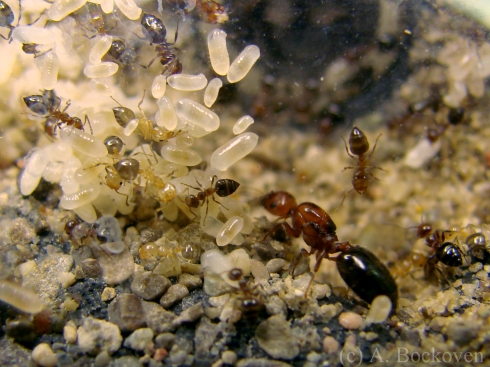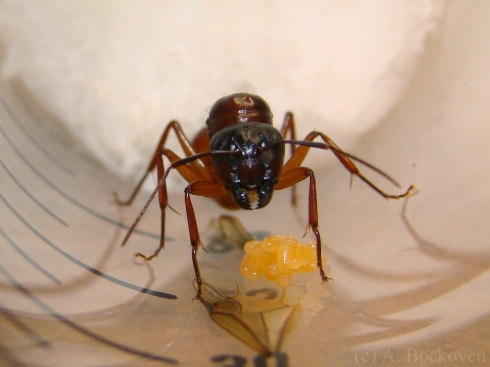
A foundress carpenter ant queen (Camponotus) tends her clutch of eggs, with her dropped wings visible in the foreground.
Lots of pictures of queen ants today. While the huge diversity of ant species have developed numerous methods for founding new colonies, a few strategies are fairly widespread in the ant world. After a nuptial flight, in which winged sexual male and female ants mate,a future queen faces the harrowing challenge of founding a new colony. With her ovipositor specialized for egg-laying she cannot even sting or spray venom. She has only her jaws to defend her and she is heavy-bodied and clumsy. Mortality is high–one reason ant colonies pump out vast flocks of winged alates. Dropping to the ground the new queen searches diligently for a nest site, shedding or pulling off her now useless wings so that she can burrow or explore small crevices more easily. The energy from her atrophying wing muscles will be used to help feed her and her developing brood.
Unless she manages to join an existing nest (some ant species such as fire ants will accept additional queens into established colonies) or co-founds with a small group of other queens (in which case surplus queens may later fight or be executed by workers) she will be alone until she manages to raise her clutch of eggs through the helpless larval and pupal stages and into small adult workers. In some species queen ants take on the risky task of foraging for food, but in many species queens practice claustral founding, closing themselves away into small nest chambers until the first workers eclose, relying entirely on the resources stored in their bodies to provision them.
During this time, queens carefully tend their precious brood, feeding them via salivary secretions or trophallaxis (regurgitation) and grooming them to prevent mold or fungal growth. Fire ant queens lay trophic (feeding) eggs, which they eat and then regurgitate to the larvae.
The first workers pupate prematurely, and eclose as unusually tiny adult ants, called minims or nanites. The pale, callow workers slowly darken and gain mobility as their exoskeletons harden. Driven by hunger and instinct, these tiny workers open up the colony and venture carefully forth for the first foraging expeditions of the colony. (Other tactics may also come into play–fire ant minims practice brood raiding, where they steal developing larvae and pupae from nearby colonies to enlarge their own labor force.) Later workers, tended by the minims and better provisioned with food, will develop normally into typically sized workers of the various castes.

A foundress fire ant queen (Solenopsis invicta) tends her brood with the help of newly eclosed minim workers.
As the worker population increases, the queen’s careful attendance of the brood slackens and her primary role in the colony becomes egg-laying and remaining alive. Rather than standing to defend her only clutch of brood queens now have a horde of daughters to defend the nest, and they retreat from any signs of danger or disturbance to the nest.

An acrobat ant queen (Crematogaster) in formacarium with brood pile, nurses, and newly eclosed workers.
These pictures are mostly foundresses I’ve captured hunting nest sites and reared out in test tubes. Ant colonies are fun to keep, and ridiculously easy to found (what other pet can you close away in a tube and ignore for the first month?). For the purposes of my research I’ve mostly reared fire ant colonies, and these are the main foundresses I encounter in my area of Texas (good for my research, not so good for the ecosystems they’ve invaded). Obviously not the ideal pet ant colony, but in a secure environment they are fun to observe and they make for sturdy, fast-growing colonies.




Fascinating stuff! Thanks for sharing.
Tempting hobby, I must say, although I don’t think I’d pick fire ants for pets. But maybe I’ll try rearing the next carpenter ant queen I see instead of my usual response.
How Can i find a queen in a small ant pile?
It really depends on the type of ant. Some ant colonies do not do well if dug up or moved. Some ant colonies are bigger than others. With fire ants you can dig them up and raft them out of the soil. But really, the best way to collect queens is to find them after a mating flight before they go to ground.
I’ve recently captured a carpenter ant and she has laid eggs! (Your first and second image are a perfect representation.) Could you give me some raising tips, like what should I feed her/them and what to expect for developmental timing? She is currently in a 30ml glass vial with a cotton plug and cornmeal/yeast/sucrose at room temperature. Thanks!
I don’t know very much about rearing carpenter ants, but in my experience the folks over at the Ant Farm are tremendously helpful with this kind of thing.
Great! Thank you.